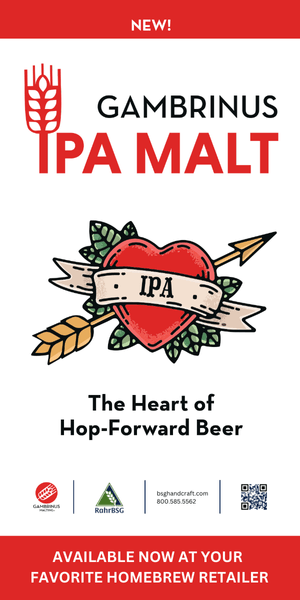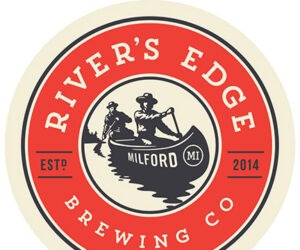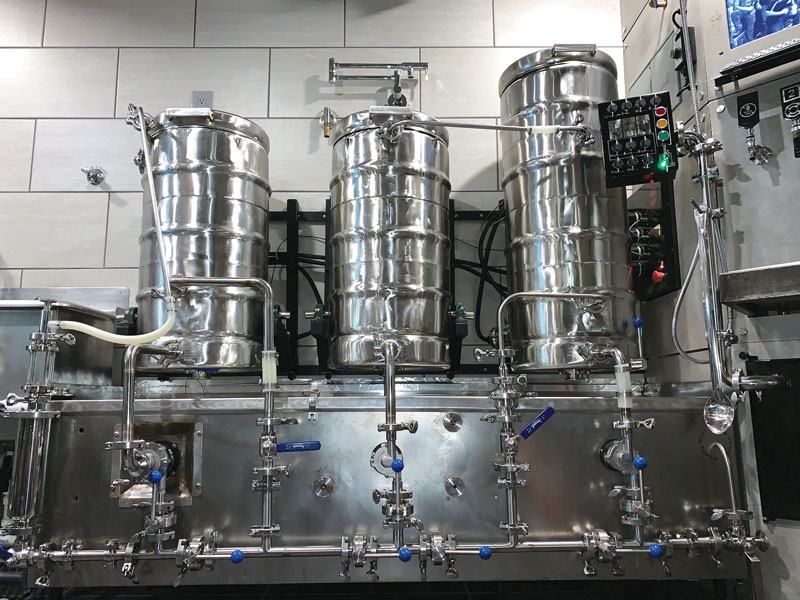Fontana Farms
Dear Replicator, Fontana Farms’ Blood Orange Pale Ale managed way more fruit flavor than any citrus beer I’ve had in a long time. I’m curious how they did it and I would love some pointers on replicating this beer that is perfect for the summer months.
Kevin Brunswick
Louisville, Kentucky
For Michael Meeks and Richard Carl, friends since high school and founders of Delphi, Indiana’s, Fontana Farms Brewery, their vision for breaking into the beer industry has always been rooted in a desire to create something that felt grounded. Inspired by small European breweries — which are often located on small personal properties — as well as innovative American operations like Illinois’ Scratch Brewing, they envisioned a farm brewery where a significant portion of the beer was intrinsically linked to the land itself.
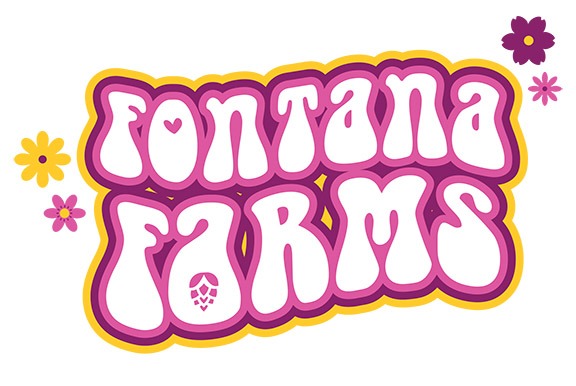
“We love outdoor venues, beer gardens, and rustic businesses,” Meeks says. Their goal was to create a space reminiscent of both Indiana wineries as well as the various breweries that inspired them along the way — small-scale production, a welcoming tasting room, and the unique charm of being deeply intertwined with the community around them.
Like many who have turned pro over the years, Meeks and Carl started as avid homebrewers. A pivotal moment came when friends of theirs opened Teays River Brewing in Lafayette, Indiana. Meeks seized an opportunity to work part-time in the cellar.
“Working one day a week for about a year, the passion became a bit of an obsession,” Meeks recalls. “We decided there was no turning back.”
Fontana Farms opened its doors in the autumn of 2023, and has already set itself apart with a brewing philosophy centered on a sense of place. “We like to be known for our unique beer that comes from here,” Meeks says. “The stuff that we grow and forage, the yeast that we collect.”
While these hyper-local brews are currently a smaller part of their output, it’s an area they’re passionate about expanding, according to Meeks.
Fontana Farms maintains a diverse beer lineup appealing to broad tastes — always featuring IPAs, a porter, a kettle sour, and a cream ale — but their seasonal and specialty beers best showcase their brewing philosophy.
“We double down on the fact that we are both a farm and have a small woods,” Meeks says. The bounty of the land dictates their brewing calendar, and thus far, they’ve incorporated a variety of foraged ingredients in their brews, including mulberries, elderberries, and dandelions.
“We are currently in the process of collecting sap from maple, black walnut, and Sycamore trees. We grow tomatoes, grapes, jalapeños, pumpkins, watermelon, horseradish, and spices that we use in our beers. We’ve also collected wild yeast to ferment. These things make us stand out and encourages people that it’s worth the drive to come find out what we are all about.”
All the extra effort required to obtain local, foraged ingredients is worth it, Meeks believes, as it serves a secondary function beyond just creating memorable beer. According to Meeks, it also helps educate their customers as to the variety of beer that can be produced even with the limited range of local ingredients, and highlights the notion that beer doesn’t have to fall within one of the select beer style categories that shoppers commonly find at the grocery store.
Though it doesn’t rely on foraged ingredients (for obvious reasons), Orange Mountain Pale Ale is a perfect example of Fontana Farms’ creative output. The beer has had a place on the brewery’s tap list from day one. Originally conceived during their homebrewing days, it has transformed significantly over the years.
“It started as a pale ale, but it has evolved tremendously,” Meeks says. Early versions included crystal 60 malt, which was eventually cut from the grain bill. The team also experimented with Munich malt to enhance the orange hue, only to discover that the blood orange addition provided ample color on its own, so Munich was then scrubbed from the recipe also. The current recipe uses aromatic malt for a touch of color — although now, they’ve realized, the beer no longer fits within the traditional pale ale profile.
“Once we run out of labels, we will likely rebrand it as another category,” Meeks says.
The goal for Orange Mountain deviates from their often subtle approach to fruited beers. “This is not one of those beers,” Meeks says. “We want the orange to be in your face.”
To achieve this assertive character, Fontana Farms employs sweet orange peel alongside the blood orange addition, and the flavor is further bolstered by a late addition of Amarillo® hops. A final touch of blood orange puree added to the brite tank provides a rounding complexity.
Balancing the prominent fruit and hop character requires careful consideration, Meeks says, noting that the blood orange itself contributes some bitterness. The result is a beer that “drinks balanced without being bitter,” successfully delivering the unambiguous punch of orange that the team aimed for.
Fontana Farms’ Orange Mountain Pale Ale clone
(5 gallons/19 L, all-grain)
OG = 1.058 FG = 1.010
IBU = 35 SRM = 6 ABV = 6.3%
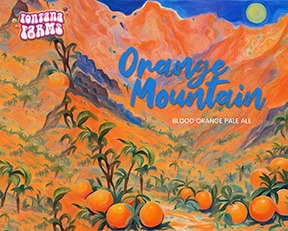
Ingredients
9.8 lbs. (4.4 kg) Pilsner malt
14 oz. (400 g) malted oats
7 oz. (200 g) aromatic malt
7 oz. (200 g) corn sugar (dextrose)
4 AAU Magnum hops (60 min.) (0.3 oz./9 g at 12% alpha acids)
11 AAU Amarillo® hops (10 min.) (1.5 oz./43 g at 7% alpha acids)
0.5 oz. (14 g) sweet orange peel (0 min.)
2.7 lbs. (1.2 kg) blood orange puree
SafAle US-05, Wyeast 1056 (American Ale), or White Labs WLP001 (California Ale) yeast
3⁄4 cup corn sugar (if priming)
Step by Step
Mash in with 2.75 gallons (10.4 L) of 166 °F (74 °C) strike water to achieve a single-infusion rest temperature of 153 °F (67 °C). Hold at this temperature for 60 minutes. With sparge water at 170 °F (77 °C), collect about 6 gallons (23 L) of wort.
Bring wort to a boil. Add Magnum hops and set timer to boil for 60 minutes. With 10 minutes remaining in the boil, add the Amarillo® hops and corn sugar (dextrose), stirring gently to dissolve the sugar. During the boil, or before, peel a couple sweet oranges using a carrot peeler to collect 0.5 oz. (14 g) orange peel. Collect only the orange peel, not the layer of white pith below it that is very bitter. At flameout, add the sweet orange peel.
Chill the wort rapidly to your target fermentation temperature, around 68 °F (20 °C). Pitch the yeast, aerating the wort first if using liquid yeast.
Ferment at approximately 68 °F (20 °C). When fermentation is nearing completion, carefully rack the beer onto the 2.7 lbs. (1.2 kg) of blood orange puree in a sanitized secondary fermenter or add the puree directly to the primary. Allow at least five days before packaging to allow the secondary fermentation to subside.
Fontana Farms’ Orange Mountain Pale Ale clone
(5 gallons/19 L, extract with grains)
OG = 1.058 FG = 1.010
IBU = 35 SRM = 6 ABV = 6.3%
Ingredients
5.4 lbs. (2.4 kg) Pilsner dried malt extract
7 oz. (200 g) wheat dried malt extract
7 oz. (200 g) crystal malt (20 °L)
7 oz. (200 g) corn sugar (dextrose)
4 AAU Magnum hops (60 min.) (0.3 oz./9 g at 12% alpha acids)
11 AAU Amarillo® hops (10 min.) (1.5 oz./43 g at 7% alpha acids)
0.5 oz. (14 g) sweet orange peel (0 min.)
2.7 lbs. (1.2 kg) blood orange puree
SafAle US-05, Wyeast 1056 (American Ale), or White Labs WLP001 (California Ale) yeast
3⁄4 cup corn sugar (if priming)
Step by Step
Place the crushed crystal malt in a muslin bag. Steep the grains in 5.5 gallons (21 L) of water as it heats up to 165 °F (74 °C) for up to 30 minutes. Remove the grain bag, allowing it to drain into the kettle.
Bring wort to a boil and then turn off the heat and carefully stir in the dry malt extracts until fully dissolved. Return to heat and boil for 60 minutes, adding the Magnum hops at the start of the boil. With 10 minutes remaining in the boil, add the Amarillo® hops and corn sugar (dextrose), stirring gently to dissolve the sugar. During the boil, or before, peel a couple sweet oranges using a carrot peeler to collect 0.5 oz. (14 g) orange peel. Collect only the orange peel, not the layer of white pith that is very bitter. At flameout, add the sweet orange peel.
Chill the wort rapidly to your target fermentation temperature, around 68 °F (20 °C). Pitch the yeast, aerating the wort first if using liquid yeast.
Ferment at approximately 68 °F (20 °C). When fermentation is nearing completion, carefully rack the beer onto the 2.7 lbs. (1.2 kg) of blood orange puree in a sanitized secondary fermenter or add the puree directly to the primary. Allow at least five days before packaging to allow the secondary fermentation to subside.
